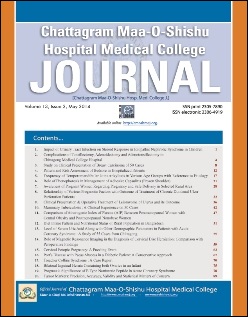Clinical Presentation & Operative Treatment of Leiomyoma of Uterus and its Outcome
DOI:
https://doi.org/10.3329/cmoshmcj.v13i2.21061Keywords:
Uterine fibroid, leiomyomata, progressive menorrhagiaAbstract
Introduction: Uterine leiomyoma is remarkably common, however only a subset of women have their fibroids clinically detected, symptomatic, or warrant surgical treatment. Mode of treatment depends on age of the patients, number, size and site of the myoma and also fertility status of the patients.
Materials & methods: To evaluate the sociodemographic, clinical characteristics, management outcome and its determinants in BSMMU, Dhaka, Bangladesh, the study was carried out. 50 patients of diagnosed leiomyoma admitted in the BSMMU, Dhaka was selected for the study. Clinical profile, type of surgery and postoperative follow up findings were noted. Data was analyzed by computer based software SPSS 18.
Results: The common complaints among the 50 patients were progressive menorrhagia (70%), abdominal swelling (50%), infertility (24%), weight in pelvis (38%), weakness/dizziness or syncopal attack after menstrual period (26%) and recurrent miscarriages (12%). The average uterine size at presentation was 15±9.7 weeks. The majority (70%) of the women presented with multiple leiomyomata. The commonest anatomical position of the myomas were multiple positions and intramural(80%). Total abdominal hysterectomy with or without bilateral sulphingo ophorectomy according to age was the commonest surgical procedure performed in thirty two (64%) cases. Myomectomy was done in 12(24%) cases and laparoscopic assisted vaginal hysterectomy was done in also 6(12%) of patients. Postoperative complications occurred in 24%(12) of the women. The most common complications were postoperative pyrexia 12%, blood loss warranting transfusion 8%, wound infection 10% and prolonged hospital stay 6%.
Conclusion: Uterine fibroid is common in our environment and most of the patients had regular menstrual cycle with progressive menorragia. Its removal is commonly associated with post-operative pyrexia, blood loss, and anemia and wound infection. Preoperative correction of anemia appropriate use of antibiotics and strict hemostasis and asepsis can reduce these complications.
Downloads
293
422
Downloads
Published
How to Cite
Issue
Section
License
Authors of articles published in CMOSHMC Journal retain the copyright of their articles and are free to reproduce and disseminate their work.
A Copyright and License Agreement -signed and dated by the corresponding author on behalf of all authors -must be submitted with each manuscript submission.

